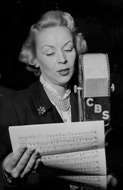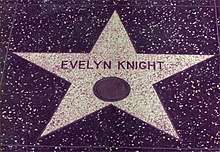Evelyn Knight (singer)
Evelyn Knight (born Evelyn Davis.,[1] December 31, 1917, Reedville, Virginia – September 28, 2007, San Jose, California) was an American singer of the 1940s and 1950s. Damon Runyon, in one of his newspaper columns, described Knight as "a lissome blonde lassie with a gentle little voice and a face mother would not mind having brought home to her."[2]
Evelyn Knight | |
|---|---|
| Born | Evelyn Davis December 31, 1917 Reedville, Virginia, U.S. |
| Died | September 28, 2007 (aged 89) San Jose, California, U.S. |
| Nationality | American |
| Other names | Honey Davis |
| Occupation | Singer |
| Home town | Reedville, Virginia |
Early years
Knight's father was "head of a geodetic survey for the government".[3] She sang soprano in the young people's choir in a church in her hometown of Reedville, Virginia.[4] After her father's death, Knight and her mother moved to Arlington County, Virginia, in 1926.[1]
When she was 16, she sang in Washington nightclubs billed as Honey Davis.[1] At the age of 18, she married Andrew B. Knight, a war photographer for the Washington Post, and became professionally known as Evelyn Knight.
Recording
During a seven-year span in the late 1940s and 1950, Knight had two No. 1 hit records and 13 that made the Top 40. Her debut recording was "Dance with a Dolly (With a Hole in Her Stocking)" for Decca Records in 1945. It became a Top 10 hit.[1]
In 1948, she recorded the million-seller[4] "A Little Bird Told Me" with The Stardusters, which was #1 for seven weeks and stayed on the charts for five months. Later that year she recorded "Powder Your Face with Sunshine"; which also reached #1 and remained on the charts well into the following year.
She had other hits including "Buttons and Bows" in 1948, which Bob Hope also sang in the film The Paleface. A list of some of her hits appears below. In 1950, she released "Candy and Cake", originally sung by Mindy Carson, and "All Dressed Up to Smile" with the Ray Charles singers. In 1951, she recorded a duet with country singer Red Foley called "My Heart Cries for You," as well as a pair of titles with Bing Crosby (see link below).
Television
Knight was among the pioneers of early television with several appearances on The Ed Sullivan Show, The Colgate Comedy Hour and a 1951 television appearance with Abbott & Costello.
Radio

Knight began her career in high school when she would sing at Washington D.C.'s Station WRC as “Honey Davis” twice a week over NBC for $16 a broadcast. (Another source says, "Her professional debut was made on a radio show coming from Charleston, South Carolina.")[3]
Knight was the female vocalist on the Tony Martin Show, which began March 30, 1947.[5] In 1948, she co-starred with Gordon MacRae on Star Theater on CBS.[6] She also was featured on Barry Wood's Million Dollar Band program and starred in "a weekly program broadcast over CBS shortwave for Latin America."[3] Knight was also a regular on Club Fifteen,[7] Happy Island,[7]:290 and The Lanny Ross Show.[7]:384
Nightclubs
One of Knight's early bookings was in the King Cole Room in Washington, D.C. An initial two-week contract eventually turned into a five-year stay.[3] Near the end of that span, a Billboard reviewer wrote, "For five years she has held down the entertainment assignment in this spot and in that five years she has grown into a local tradition ... Cool and with plenty of glamour, this girl delivers her stuff in a sophisticated manner ..."[8] She also sang in such high-end Washington supper clubs as The Claridge Hotel.
After many successful years in Washington, Knight moved to New York City, where she began headlining at such Manhattan nightclubs as The Blue Angel[3] and the Plaza Hotel's Persian Room.[9] She launched her recording career in 1945 by signing with Decca records, and moved to Los Angeles in the late 1940s where she headlined frequently at the celebrity-studded Ciro's and Coconut Grove. For the next 10 years she was a staple all over the country on the popular "supper club" circuit of the day.
Recognition

Knight was among the original 1,500 stars on the Hollywood Walk of Fame. Her star, dedicated February 8, 1960, is at 6136 Hollywood Boulevard, in the "Recording" section.[10] A 1947 newspaper article reported, "She has given three 'command performances' for President Truman."[5]
A 2018 television advertisement entitled Lucky Guy featured Knight's version of the song "Lucky Lucky Lucky Me". The advertisement promotes the South-Korean automobile manufacturer Hyundai's Tucson car. This advert shows the strenuous daily routine of a family man, as well as the lucky hours, in which he can be happy with his family during a free day. Two older men sitting in a street cafe observe the luck of this family. In a reference to the lyrics of "Lucky Lucky Lucky Me", one of these older men comments "That's one lucky guy".[11][12]
Family

Divorced from Knight she married Johnny Lehmann, a songwriter with top ten hits of his own, in 1951. Her son, Andrew Knight Jr. (1940–1989) became a well-regarded concert tour lighting technician in the seventies working with The Rolling Stones, Pink Floyd and The Who, among others.[13] Her second child, Fran (born 1954) worked for many years in Californian radio, most notably as a disc jockey for San Francisco radio station KOME.[14]
Last years
Knight's obituary in The Washington Post reported, "she abruptly retired from show business in her 30s, never to return to the spotlight."[1] She and her family moved to Phoenix, Arizona in 1969 where she lived until 2007. Following a decline in health in 2007, she moved to San Jose, California to live with her daughter. She died quietly on the morning of September 28, 2007, aged 89, from lung cancer.
Charted singles
| Year | Single | US Chart[15] |
|---|---|---|
| 1944 | "Dance with a Dolly (With a Hole in Her Stocking)" | 6 |
| 1945 | "Chickery Chick" | 10 |
| 1948 | "A Little Bird Told Me" | 1 |
| "Brush Those Tears from Your Eyes" | 9 | |
| "Buttons and Bows" | 14 | |
| "Powder Your Face with Sunshine (Smile! Smile! Smile!)" | 1 | |
| 1949 | "You're So Understanding" | 21 |
| "It's Too Late Now" | 22 | |
| "A Wonderful Guy" | 22 | |
| "Be Goody Good Good to Me" | 29 | |
| 1950 | "Candy and Cake" | 20 |
| "All Dressed Up to Smile" | 25 | |
| 1951 | "My Heart Cries for You" | 28 |
References
- Schudel, Matt (October 28, 2007). "Evelyn Knight; Torch Songstress Began Career in D.C. Clubs". The Washington Post. Retrieved March 18, 2016.
- Runyon, Damon (January 8, 1946). "The Brighter Side". The Indiana Gazette. Indiana, Pennsylvania. p. 14. Retrieved March 17, 2016 – via Newspapers.com.

- "It's a Lovely Knight" (PDF). Radio Mirror. October 1944. p. 54. Retrieved March 17, 2016.
- "Evelyn Knight's Switch Hit Nation's Juke Box Jackpot". The Austin American. Austin, Texas. February 6, 1949. p. 23. Retrieved March 17, 2016 – via Newspapers.com.

- "Tony Martin Show Opens Sunday on WHP; Evelyn Knight; Bob Hope Star". Harrisburg Telegraph. Harrisburg, Pennsylvania. March 29, 1947. p. 17. Retrieved March 17, 2016 – via Newspapers.com.

- "Gordon MacRae Is Star of WHP 'Star Theater'". Harrisburg Telegraph. Harrisburg, Pennsylvania. January 3, 1948. p. 17. Retrieved March 17, 2016 – via Newspapers.com.

- Sies, Luther F. (2014). Encyclopedia of American Radio, 1920-1960, 2nd Edition. McFarland & Company, Inc. ISBN 978-0-7864-5149-4. P. 139.
- Stinnett, Caskie (June 26, 1943). "Reviews: Evelyn Knight" (PDF). Billboard. p. 20. Retrieved March 18, 2016.
- Heimer, Mel (April 21, 1950). "My New York". The Daily Notes. Canonsburg, Pennsylvania. p. 2. Retrieved March 17, 2016 – via Newspapers.com.

- "Evelyn Knight". Hollywood Walk of Fame. Retrieved 17 March 2016.
- Danielle Gibson (14 August 2018). "UK Top Shazamed ads: Samsung, Heineken and Hyundai". The Drum. Retrieved 5 September 2019.
- "Hyundai Tucson Advert Song 2018 - Lucky Guy". TV Ad Videos / TV & Internet Commercials. Retrieved 10 February 2019.
- "Torch singer Evelyn Knight dies". Monterey Herald. 2007-10-29. Retrieved 2019-06-28.
- McManis, Sam (2003-02-09). "Free to be Fran: After years of leading a secret life, it was time to make the most important decision of her life". SFGate. Retrieved 2019-06-28.
- Whitburn, Joel (1986). Pop Memories: 1890-1954. Record Research.